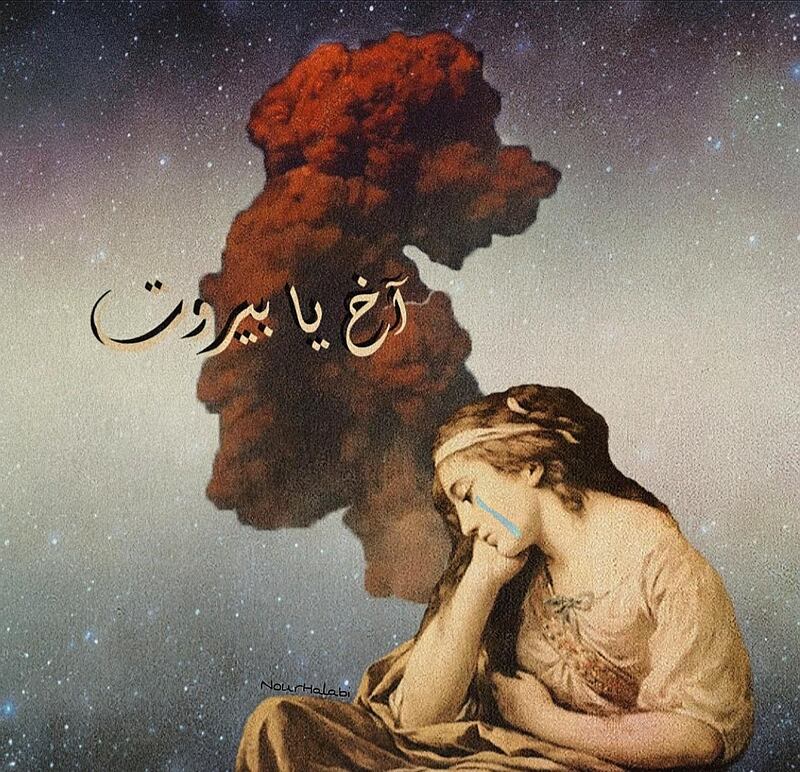On August 4, a huge explosion devastated the Lebanese capital of Beirut. The historic city was left in chaos, with shattered glass and debris on the streets.
As the people come together to recover and clean up, protesters have begun marching to demand their leaders are held accountable. Meanwhile, several artists have turned to their work to reflect the complex mood gripping the country – grief, anger, sorrow, all tinged with unending hope for a better Beirut.
Here are 10 artworks that speak to the moment ...
Omar Mougharbel, 27, art director
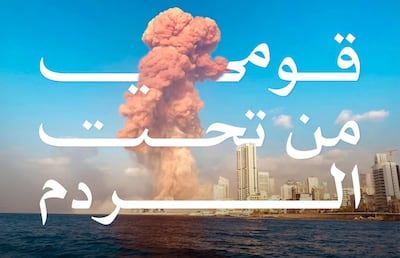
Mougharbel, who lives in Saudi Arabia, placed a line from the Nizar Qabbani poem Ya Beirut (Oh Beirut), famously sung by Majida El Roumi, over an image of the blast for this work. He says it is a statement for the Lebanese people, as the words say, to "rise from the rubble".
"Beirut is the city that I was born in and grew up in. All my memories were shared in its streets and alleyways. No one can detach us from our Beirut, its history and culture," he tells The National. "We always used to hear stories that Beirut has been destroyed seven times, and now the eighth is the most destructive one, physically and emotionally. But we never give up. No one can overtake our revolution and no one should lose hope in our beloved Beirut."
Nour Halabi, 20, university student
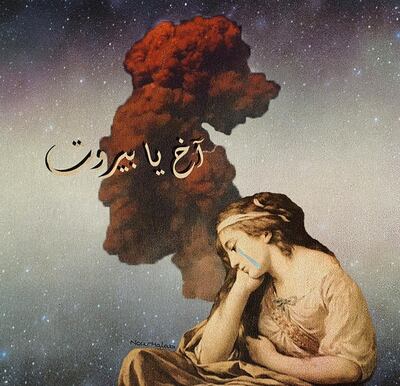
Mixing old and new, Halabi created a composite of Louis-Jean Francois Lagrenee's painting La Melancolie and the red plume of smoke that rose from the site of the blast. "I chose La Melancolie because the girl's expression and posture portray pensive sadness. To me, her body language shows a woman who has suffered from depression, a woman whose banks of hope have been depleted," Halabi says.
“This is the general mood when it comes to Lebanon – lack of hope. The explosion has not only erased any trace of hope, it has devastated us completely. I think this is the last straw.”
Nour Flayhan, 29, illustrator
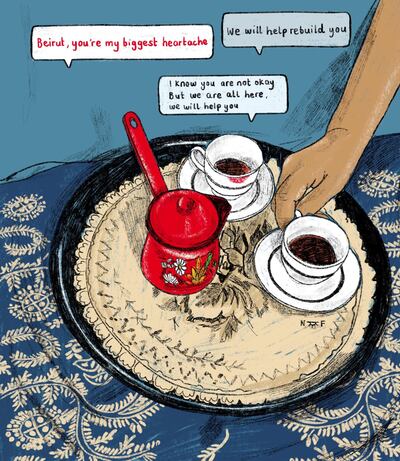
Known for her psychedelic images of young women, Flayhan takes her inspiration from childhood memories of summers in Lebanon. In this work, the American-Lebanese artist offers words of comfort to Beirut. The work reads: “I know you are not OK. But we are all here, we will help you” and “we will help rebuild you".
As part of the Lebanese diaspora, she says she wants to offer help through her art, accepting commissions for work with all proceeds going to charities in Lebanon.
Tony Maalouf, 35, interior architect
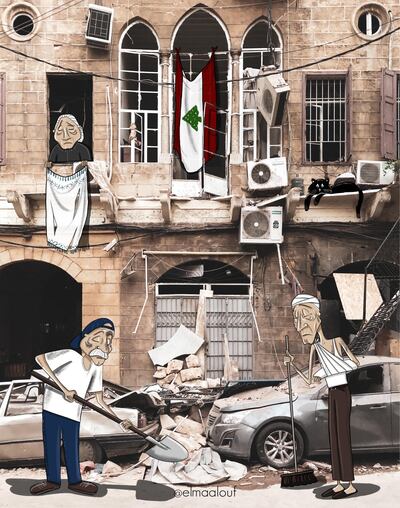
In his cartoon and photo collages, Maalouf says he tries to find ways of depicting Lebanon’s rich cultural background in a modern and authentic way. “I sketch daily life and mix it with photography, to show reality with a twist,” he explains.
The image used in this work was originally taken in Gemmayzeh, a bustling historic neighbourhood that was the heart of Beirut’s social and artistic scene. The streets are now covered with debris.
“Like every Lebanese person, I’m still in shock and processing August 4 with mixed feelings of anger, sadness and disbelief,” Maalouf says.
Omar Abdallat, 41, cartoonist
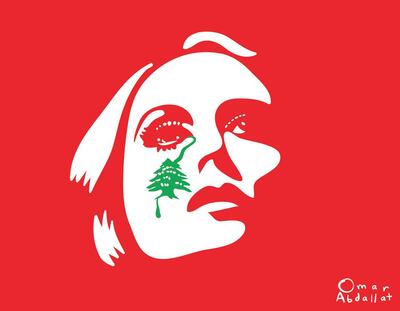
In the world of Arabic music, the talent of Lebanese singer Fairouz remains unmatched, the cartoonist says, which is why he chose her face as the basis for this graphic work.
"Whenever I hear the word 'Lebanon', I immediately think of Fairouz," he says. "Beirut is a city of culture and Fairouz is everything that is beautiful in Lebanon. Like the country, she's beautiful, no matter the circumstances. I hate to see Beirut, the capital of beauty, like this.
"I wish that this tragic event is a wake-up call for those who have caused this. No one will rebuild Beirut but its people.”
Shirien Damra, 33, designer and illustrator
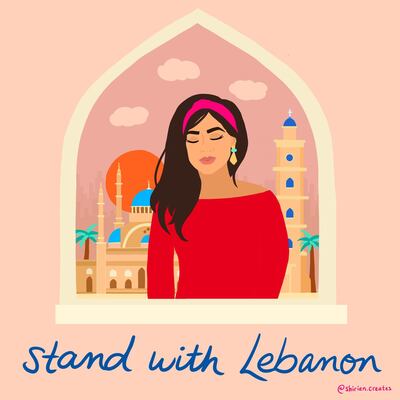
“Art can be a powerful catalyst in bringing people together to take action against systemic oppression and to envision a better future. In this moment, we shouldn’t just create art for art’s sake, but to inspire action and change,” Damra says. She believes that art has the power to connect marginalised communities as well.
“As a Palestinian, I know our history and struggle are tied together. I hope there will come a day when we can heal the wounds from years of colonisation and occupation. We deserve love, happiness, peace and safety. We deserve a bright future.”
Racha El Abbas, 40, designer
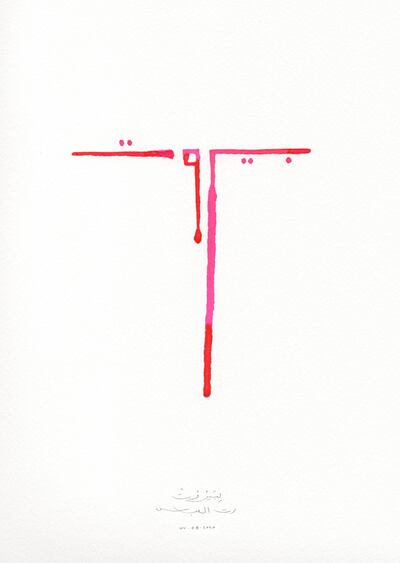
“Beirut is my place of birth. Beirut raised me,” El Abbas, who runs a design studio in Dubai, says.
After hearing the news on TV, she headed to her studio and created this work, which reads "Beirut".
“This is the most personal expression I’ve ever made in my art. All my feelings were charged and I needed to process them," she says. "It’s simple, but honest. Beirut is bleeding.”
Adra Kandil, 26, visual artist
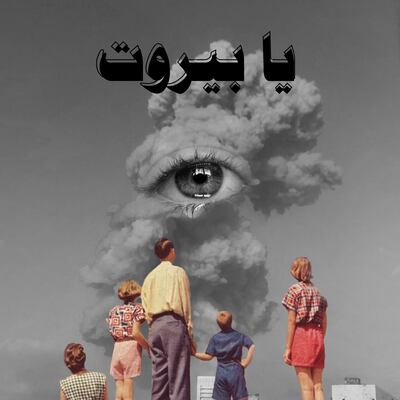
Kandil’s surrealist poster-style image reflects the artist’s nostalgia. “Being a child of the 1990s, I never witnessed my country’s golden age, when people called it the ‘Paris of the Orient’. The days when everything was simpler, sentimental and slow,” she says.
"The nostalgia comes from the stories my parents and grandparents told me – the hope and happiness in their voices, the spark in their eyes."
Fast-forward to today and Kandil says she still believes in what Beirut can be. “To be honest, I’m terrified but there’s hope. There will always be hope for my city. Yes, I'm tired of being resilient, I'm tired of trying and waiting and hoping, but I’ll never give up on Beirut. I will do everything I can to keep my home standing.”
Nour Ayoub, 29, illustrator
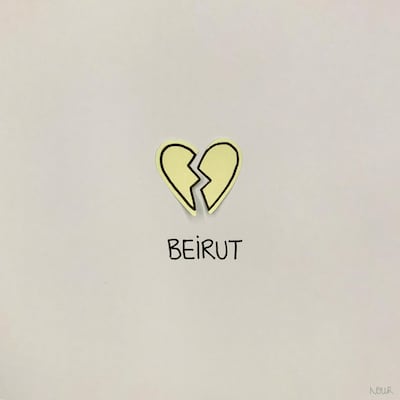
Ayoub was in her office in the centre of Beirut when the explosion hit. Though in shock, she managed to make her way home, where she expressed her grief and guilt in this collage.
“We are the ones who got away … there is relief, so much relief, but there is also guilt that we are the ones still standing, that we have roofs over our heads, that our friends and family are safe and well, that we have been spared this time, too,” she says.
“But this is a ticking time bomb of a country… how many more times will we get away? How many more times will we be spared?”
Tom Young, 48, artist
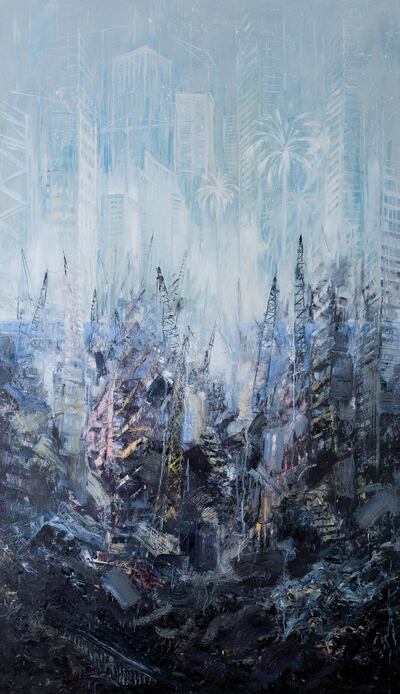
While the other artworks were created in response to the tragedy, this piece, painted in 2014, was affected by it.
Dividing his time between Beirut and London, Young's training in architecture is seen in the way he renders space and scale in his paintings. Rise and Fall from 2014 shows the cranes of Beirut port with a desolate scene of neglect below. The painting was torn by flying pieces of shattered glass during the explosion.
It is an eerie reflection of the current state of ruin in Beirut. "As an artist, I'd like to offer some creative meditation for people to begin processing the pain and trauma," he says. As a witness to this tragedy, I feel a responsibility to respond artistically. I'd like to spread meaningful energy through my art, and give back to a place and people who give me so much. I have no intention of leaving Beirut now. This is the time to stay and help rebuild."
__________________________
Read more:
How the UAE arts community is helping raise funds for Beirut
'Nothing is normal after this': explosions in Beirut leave art scene broken
Life in Post-Its: How one Lebanese illustrator is turning her doodles into artistic collages
__________________________
